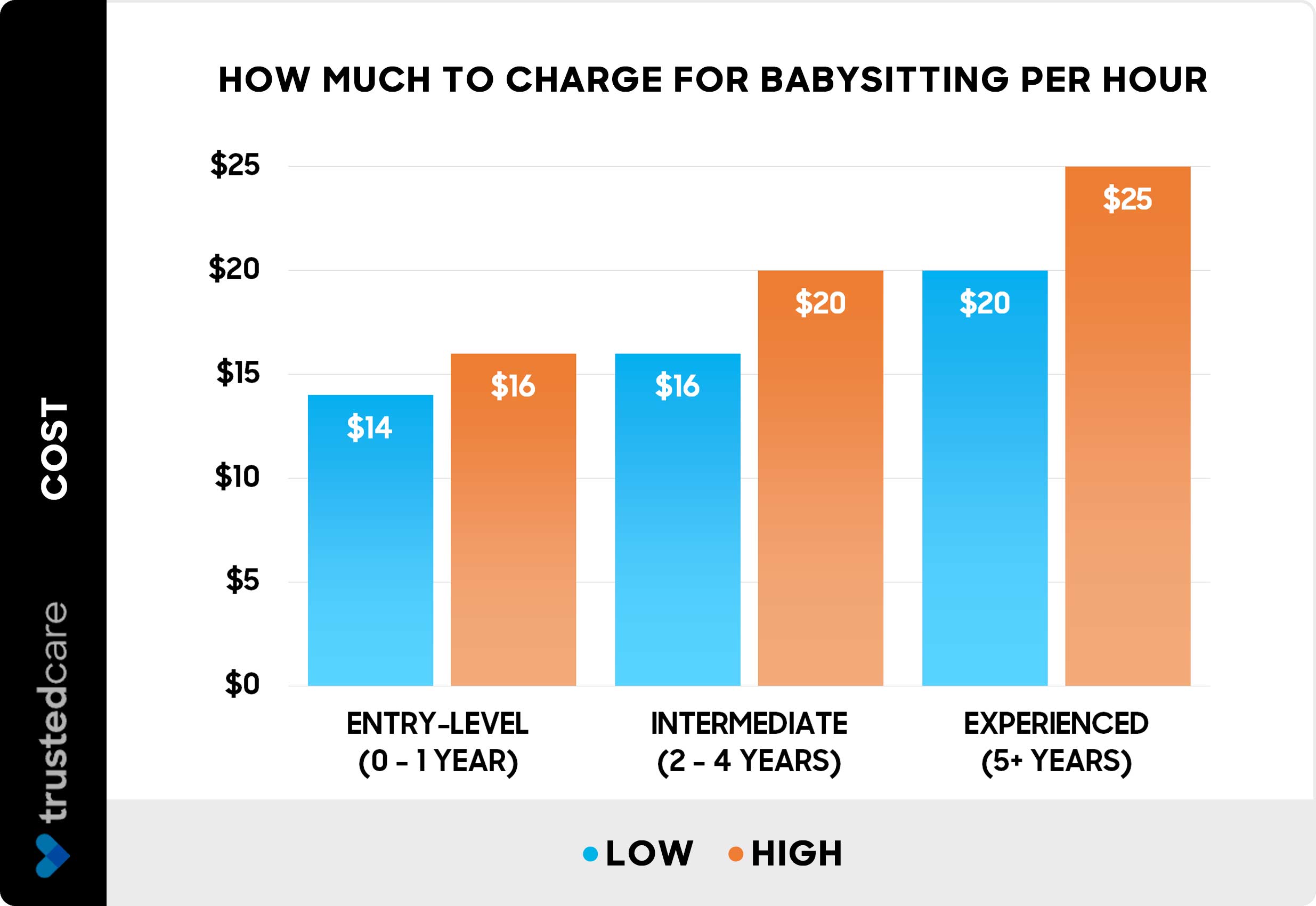
How Much to Charge for Babysitting
How Much to Charge for Babysitting
How much should I charge for babysitting?
Wondering how much to charge for babysitting? Whether you're a new sitter or seasoned pro, setting the right rate is crucial to ensure you're fairly compensated while remaining competitive. This guide will help you determine your ideal babysitting rate based on your experience, location, and other important factors.
| Fee structure | Average rate* |
|---|---|
| Per hour | $14 – $20 |
| Per day (8 hours) | $110 – $160 |
| Overnight (24 hours) | $150 – $275 |
| Weekend (2 nights) | $300 – $550 |
| Per week (35 – 40 hours) | $500 – $800 |
*Average rate to care for 1 child
Factors that should influence your babysitting rate
Setting your babysitting rate isn't just about picking a number that sounds good. Several factors should influence how much you decide to charge so you arrive at a fair rate that reflects your skills and the specific job requirements. Let's break down these important considerations that will help you determine your ideal rate.
Your experience level
Your experience is one of the most important factors in determining your rate. If you're just starting out, you might charge on the lower end of the scale for your area. As you gain more experience, you can gradually increase your rates.

| Experience level | Average hourly rate |
|---|---|
| Entry-level (0 – 1 year) | $14 – $16 |
| Intermediate (2 – 4 years) | $16 – $20 |
| Experienced (5+ years) | $20 – $25+ |
Your qualifications & training
Special skills and certifications can significantly boost your value as a babysitter. Parents are often willing to pay more for sitters with formal training in childcare safety.
First aid and CPR certification: This essential qualification can add $1 to $2 to your hourly rate. Parents feel more secure knowing you can handle emergencies.
Early childhood education: If you have formal education in child development or early childhood education, you can charge a premium rate.
Special needs training: Specialized training for caring for children with special needs can command significantly higher rates, often $25 to $35+ per hour.
Additional responsibilities
If you're expected to do more than just watch the children, you should charge accordingly. Additional duties might include:
| Service | Typical rate adjustment |
|---|---|
| Meal preparation | + $1 – $2 per hour |
| Transportation / driving children | + $2 – $3 per hour* |
| Homework help / tutoring | + $2 – $5 per hour |
| Light housekeeping | + $1 – $3 per hour |
*Plus possible reimbursement for gas
Number & age of children
It's standard practice to increase your rate for additional children, which means more responsibility and work. For 2 children, add $1 to $3 per hour to your base rate. For 3 or more children, add $2 to $5+ per hour, depending on the number of kids and the level of care they'll require.
The age of the children you're watching also affects your rate. Infants and toddlers require more hands-on care than older children. A typical breakdown based on age:
Infants (0 to 1 year): Add $1 to $3 per hour to your base rate.
Toddlers (1 to 3 years): Add $1 to $2 per hour to your base rate.
School-age children (4+ years): Standard base rate
Time of day & special circumstances
Certain times and situations warrant higher rates due to their inconvenience or special nature. Most sitters charge more for nights, weekends, and holidays when the demand is higher. Last-minute bookings also tend to fetch higher rates.
| Factor | Additional cost |
|---|---|
| Holidays | + $3 – $5 per hour for most holidays, and up to twice the regular rate for NYE |
| Night shift | + $3 – $5 per hour |
| Last-minute | + $2 – $3 per hour |
| Guests | + $2 – $3 per hour per guest |
Where you live
Your location has a significant impact on what an appropriate babysitting rate might look like for you. The following table shows the average hourly rates babysitters charge in each state. Rates are higher in major cities and areas with a higher cost of living, so adjust your rates accordingly.
| State | Average hourly rate (1 child) |
Average hourly rate (2+ children) |
|---|---|---|
| National average | $14.00 – $20.00 | $15.00 – $25.00 |
| Alabama | $13.20 – $18.85 | $14.10 – $23.55 |
| Alaska | $15.65 – $22.35 | $16.80 – $27.95 |
| Arizona | $13.55 – $19.35 | $14.50 – $24.20 |
| Arkansas | $12.05 – $17.20 | $12.90 – $21.50 |
| California | $14.35 – $20.50 | $15.40 – $25.65 |
| Colorado | $15.30 – $21.85 | $16.40 – $27.30 |
| Connecticut | $13.85 – $19.75 | $14.80 – $24.70 |
| Delaware | $14.55 – $20.80 | $15.60 – $26.00 |
| District of Columbia | $16.45 – $23.50 | $17.60 – $29.35 |
| Florida | $10.85 – $15.50 | $11.65 – $19.40 |
| Georgia | $12.25 – $17.55 | $13.15 – $21.90 |
| Hawaii | $15.10 – $21.60 | $16.20 – $27.00 |
| Idaho | $13.70 – $19.55 | $14.65 – $24.45 |
| Illinois | $14.10 – $20.15 | $15.10 – $25.15 |
| Indiana | $13.85 – $19.75 | $14.80 – $24.70 |
| Iowa | $13.65 – $19.50 | $14.65 – $24.40 |
| Kansas | $12.95 – $18.55 | $13.90 – $23.15 |
| Kentucky | $12.65 – $18.05 | $13.55 – $22.55 |
| Louisiana | $12.45 – $17.75 | $13.30 – $22.20 |
| Maine | $14.10 – $20.10 | $15.10 – $25.15 |
| Maryland | $14.10 – $20.15 | $15.10 – $25.20 |
| Massachusetts | $15.90 – $22.70 | $17.00 – $28.35 |
| Michigan | $12.65 – $18.10 | $13.60 – $22.65 |
| Minnesota | $14.25 – $20.35 | $15.25 – $25.45 |
| Mississippi | $13.75 – $19.65 | $14.75 – $24.60 |
| Missouri | $13.65 – $19.50 | $14.60 – $24.35 |
| Montana | $13.35 – $19.05 | $14.30 – $23.85 |
| Nebraska | $13.85 – $19.80 | $14.85 – $24.75 |
| Nevada | $14.80 – $21.15 | $15.85 – $26.45 |
| New Hampshire | $14.15 – $20.20 | $15.15 – $25.25 |
| New Jersey | $14.75 – $21.10 | $15.80 – $26.35 |
| New Mexico | $14.10 – $20.15 | $15.10 – $25.15 |
| New York | $15.90 – $22.70 | $17.05 – $28.40 |
| North Carolina | $13.20 – $18.90 | $14.15 – $23.60 |
| North Dakota | $15.40 – $22.00 | $16.50 – $27.50 |
| Ohio | $13.85 – $19.75 | $14.80 – $24.70 |
| Oklahoma | $13.45 – $19.20 | $14.40 – $24.00 |
| Oregon | $15.35 – $21.95 | $16.45 – $27.45 |
| Pennsylvania | $14.60 – $20.85 | $15.60 – $26.05 |
| Rhode Island | $14.25 – $20.35 | $15.25 – $25.45 |
| South Carolina | $13.50 – $19.30 | $14.45 – $24.10 |
| South Dakota | $14.55 – $20.80 | $15.60 – $25.95 |
| Tennessee | $13.20 – $18.85 | $14.15 – $23.55 |
| Texas | $13.55 – $19.35 | $14.50 – $24.20 |
| Utah | $13.25 – $18.90 | $14.20 – $23.65 |
| Vermont | $15.45 – $22.10 | $16.55 – $27.60 |
| Virginia | $14.40 – $20.60 | $15.45 – $25.75 |
| Washington | $16.45 – $23.55 | $17.65 – $29.40 |
| West Virginia | $11.25 – $16.10 | $12.05 – $20.10 |
| Wisconsin | $14.70 – $20.95 | $15.75 – $26.20 |
| Wyoming | $14.00 – $19.95 | $14.95 – $24.95 |
How to research babysitting rates in your specific area
To determine the most competitive rate for your services in your specific location, try the following approaches:
Ask other babysitters: Connect with other sitters in your area through social media groups or community boards to learn what they're charging.
Check online: Look for local babysitters' rates on platforms like TrustedCare.com.
Check local parenting groups: Many areas have Facebook groups where parents discuss childcare. You can observe what parents expect to pay.
Survey your current clients: If you already have some babysitting jobs, ask your clients what the going rate is in your area.
Check local daycare pricing: Babysitters often charge about half the going rate for daycare.

How to confidently discuss your babysitting rates with parents
Many sitters feel uncomfortable discussing money, but being clear about your rates is professional and prevents misunderstandings.
Be upfront: Discuss your rates during initial conversations with parents, before accepting a job.
Explain your rate structure: Clearly outline how you charge for additional children, special circumstances, or extra responsibilities.
Provide a rate sheet: Consider creating a simple document outlining your base rates and additional charges that you can share with potential clients.
Know your worth: Remember that babysitting is skilled work. Don't apologize for charging fair rates that reflect your experience and the value you provide.
Offer references: Families are willing to pay more for sitters with strong references and a proven track record.
Stay flexible: If you're just starting out, you may need to charge a bit less to build experience, then raise your rates as you gain more jobs and skills.
When and how to increase your rates
As you gain experience and skills, you should periodically review and adjust your rates.
Annual increases: Consider raising your rates by $1 to $2 per hour each year to account for increased experience and inflation.
After gaining new certifications: When you complete new training or certifications, it's appropriate to increase your rates.
When starting with new families: It's often easier to set higher rates with new customers than to raise rates with existing ones.
For current clients, give at least 2 to 4 weeks' notice when implementing a rate increase and use a simple, professional text or email. By setting fair, competitive rates, you acknowledge the importance of your work while building a sustainable babysitting business.